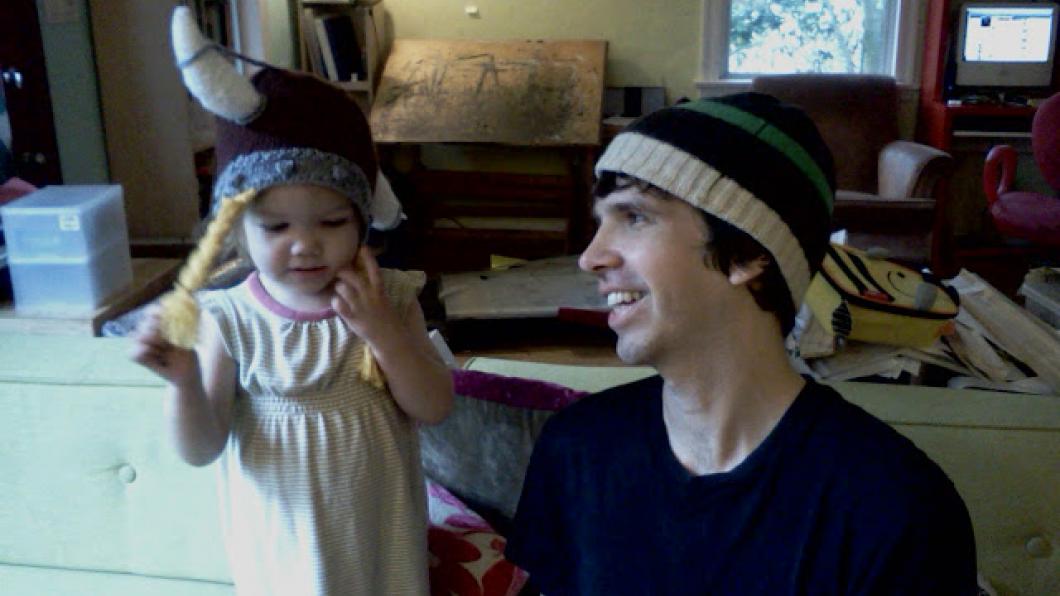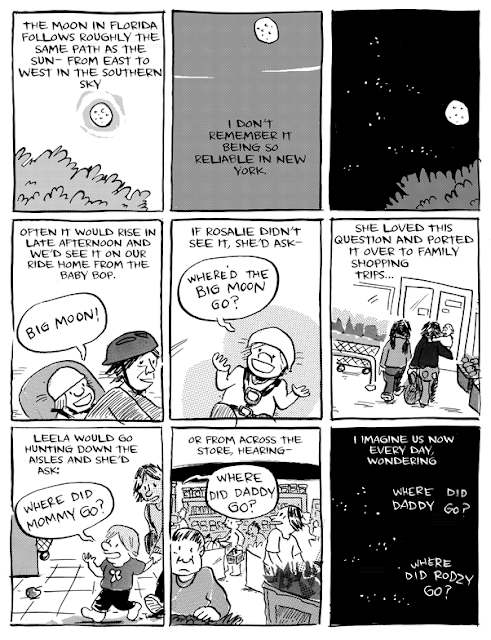
A novel drawn from light and loss
By Louise Kinross
In 2011, cartoonist Tom Hart was living an idyllic life in Gainesville, Florida. While his wife Leela, also a cartoonist, worked on a book, he spent time with his daughter Rosalie, not yet 2—bike-riding, visiting ducks in the pond, tracking the moon, painting watercolours on the back-porch.
Then Rosalie died suddenly and unexpectedly.
Tom did what he'd always done: he began writing, furiously, and then drawing, about it. His graphic memoir Rosalie Lightning was released last month.
BLOOM: How soon after Rosalie died did you start writing about it?
Tom Hart: I wrote to stay sane pretty instantly. When I wasn’t walking around the neighbourhood with my wife, or sort of lying down on the grass or in bed, I was writing mostly. In some cases it was just recording what was happening. More often it was trying to understand something and stave off despair.
We did a bit of travelling to get out of town—because town was so hurtful—so I kept the writing and the notebook going. After about five weeks I had a binder of notes. I felt it was time to stop, partly because I was repeating and partly because what happened at the end of the book was that this little girl came up to me, and that was a sign that I should stop writing.
I took some time off and then began the process of turning it into a narrative, and that took about three-and-a-half years.
BLOOM: What role did drawing and writing play in grieving for Rosalie?
Tom Hart: I’ve always used comics—this mixture of words and pictures and cartoons and boxes as a way to navigate the emotional world. Even as a child my first memory at age seven or eight is of tracing Peanuts—Charlie Brown. I later realized that I was really drawn to the emotional content: people were screaming and fighting and there was lots of punching. It was a way I learned to comprehend the larger emotional world. So unconsciously, throughout most of my life, I’ve always taken whatever I’m feeling and tried to wrestle with it on the page.
BLOOM: How did drawing help you focus on all of the details you wanted to remember about Rosalie?
Tom Hart: I wound up wanting to focus on how lively she was, and how the time up till she died was so fun and so magical. I wanted to recap it and recount it for people. It seemed strange, when I looked back at it, to want to draw all that stuff. In a way I think I was trying to summon her back. And again, since I have drawn cartoon characters for so long, it seemed like the most direct way to try to capture her spirit somehow, or to connect to her spirit.
BLOOM: What’s the main theme of the book?
Tom Hart: It’s trying to show a person’s mind as they work from a state of complete shock to some sort of comfort or integration with their new experience. Since reality has been so uprooted, it’s trying to find signs from outside of how to exist in this new reality, of how to work within a new world.
BLOOM: It seemed like the book was alternating back and forth between the beauty and pain that comes from the mystery of life. So on the one hand, we see Rosalie’s reactions of wonder to things like the 'big moon' or how acorns contain what will be a tree. But on the other, we feel your unbearable loss when she dies.
Tom Hart: It’s nice that you came away with that. I did the book very intuitively. Had I thought through what you just said ahead of time, it would have been a good structuring device. The world is big and full of joy and sorrow and bouncing or oscillating between the two is what I was trying to capture. In doing the book I really just followed my nose.
BLOOM: I think when a child has a disability, or an illness, or dies, it’s hard for parents to accept the random nature of it. In your book you go over the events immediately prior to Rosalie’s death. It seems like you’re trying to decipher the 'why' or the meaning of it. Was there a cause? Should you have anticipated it? Can you talk about that?
Tom Hart: The world is full of random, horrible circumstances and there’s not a lot of justice in the world. There’s not a larger justice in the world. To be honest, in my case I think I was able to do this book because it was so random. I think if she had had some prolonged illness, or worse, if there was a violent cause of her death, or someone to blame, I would have been a lot more immobilized.
I think a lot of what the book was about was trying to come to believe that there was cosmic purpose, because it seemed so cosmically ordained in some ways. In a weird way it was empowering that it was random and sudden and without an immediate way to comprehend it. There was nobody to blame and no blame on a personal level. That enabled me to stay focused on her spirit and on my moving on.
Early on I intellectually understood I needed to accept it, because there was no going back. It happened. Of course it’s very easy to say things intellectually, or to write them, or in your best moments to believe them. More often than not our emotional bodies are so much slower. For me I knew I had to find a way to exist with Rosalie in my memory.
It took me three years to incorporate those five weeks of writing—the lessons and ideas that came out. At the end of finishing the book I do feel like I’ve integrated that experience, so that I no longer live in denial of it.
BLOOM: Over time did your need to find a meaning for the tragedy change? Or did you just stop asking the question?
Tom Hart: If there’s a larger meaning, I can’t comprehend it. I’m not a religious person, but I have an inclination toward the spiritual. Every major religion in its own way says you can’t know God’s reasons. It’s too big for our consciousness. It’s unknowable.
And the sad thing is that it’s mostly injustice down here on the physical plane. At some point everybody has to find the balance between seeing that clearly and moving on anyway. They have to square that with their own drive to stay alive and care for their loved ones.
BLOOM: Time is an important theme in the book.
Tom Hart: Is it? I haven’t read the book in a while.
BLOOM: I guess because before Rosalie died time was moving in the way you expected, and you had a sense of how it would continue as she grew up. You had dreams of her future.
Tom Hart: There was this horrible ending of what seemed like ordinary life. Up till then, time made sense. When this happened, there was no time. Time became different. There was only 'before' or 'after,' and how time was measured seemed different.
BLOOM: There’s a panel where you write 'the hospital – no I don’t like that part.' Were the professionals at the hospital compassionate in the care they gave you?
Tom Hart: There was never any hope, but for the most part everybody was compassionate.
BLOOM: Your depiction of Rosalie brings her to life. She’s such a character—from the way she spoke, to the way she moved, and how she brought what you read together in books or saw in movies into her own life.
Tom Hart: That’s really nice. It was part of my plan, but not the biggest part. I think mostly the book was me trying to get through it. But early on someone said to me that a person never dies, or their spirit never dies, until the people they’ve touched die.
It made me realize I had an opportunity to keep her spirit alive, especially in the way she was so alive for me, so vivacious. So it’s something I wanted to do—not exactly capture her spirit, but have it come through on the page.
And I needed to have that connection with her. It was very strange to draw her alive and happy. It was such a contradiction. Drawing those images was fun and delightful and horrible.
BLOOM: Did you have any hesitation about writing such an honest book?
Tom Hart: I didn’t have any hesitations about it. I’d been making books or stories for so long and I was so utterly broken open for that entire time that it didn’t matter whether or not it was too revealing or I was being too honest.
BLOOM: What do you hope people take away from it?
Tom Hart: I think I joked to another interviewer that I have such a long history of no one reading my work that I don’t have many expectations at all. I needed to do the book for my own sake and it really helped me in my grieving.
I think I needed to integrate the experience so it was no longer something I denied. I intended to do that in the way I’ve most dealt with the world, which is through writing and drawing.
For three years I was forced to focus on that time when my life changed so dramatically and become that new person. I became the person that has this in his past and has this experience in his heart. In general I did the book for my own healing.



